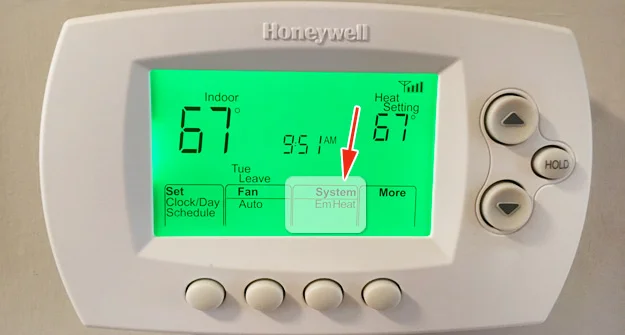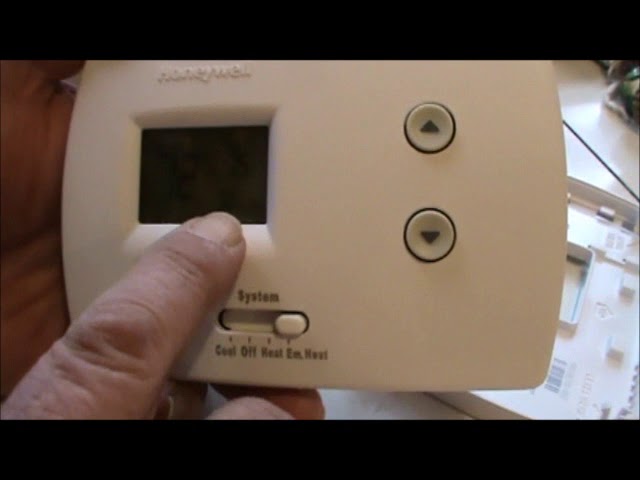Check Best Thermostat Pricing in Amazon
** As an Amazon Associate, I earn from qualifying purchases.
“Em Heat” stands for emergency heat on your thermostat. It is a backup heating system.
Emergency heat is used when your main heating system fails. This feature is common in heat pump systems. Heat pumps are efficient but may struggle in very cold weather. In such cases, the “Em Heat” setting kicks in, using a different heat source.
This ensures your home stays warm even if the main system cannot keep up. Understanding “Em Heat” can help you manage your thermostat better. Knowing when to use it and why is crucial for maintaining comfort and efficiency in your home. Let’s explore the details and benefits of this emergency heat setting.

Credit: appliance-dr.com
Introduction To Em Heat
Understanding your thermostat settings can be confusing. One term that often puzzles users is “Em Heat.” This blog post will explain what Em Heat means and clear up common misconceptions. Let’s dive into the essentials of Em Heat on your thermostat.
Definition
Em Heat stands for Emergency Heat. It is a backup heating system. When the primary heat pump fails or cannot keep up, Em Heat activates. This setting uses electric resistance heat or a gas furnace. It ensures your home stays warm during extremely cold weather or system malfunctions.
Common Misconceptions
Many think Em Heat is a regular heating mode. It’s not. Em Heat is only for emergencies. Using it all the time can be costly. Another misconception is that Em Heat warms your home faster. It doesn’t. Em Heat is less efficient than your heat pump. It’s a backup, not a primary source.
How Em Heat Works
Em Heat, short for Emergency Heat, activates the backup heating system on a thermostat. It kicks in when the primary heat source fails or can’t keep up with the cold.
Understanding how Em Heat works can help you make the best use of your thermostat, especially during the colder months. Em Heat, short for Emergency Heat, is a backup heating system used in heat pumps when the primary heating fails or can’t keep up with the cold. Let’s dive into the details of how Em Heat functions and what you need to know about its activation and energy usage.System Activation
When you switch your thermostat to Em Heat, you’re essentially bypassing the heat pump’s primary mechanism. The system activates an auxiliary heating source, typically electric resistance heaters, to provide warmth. This feature is crucial during extremely cold weather when your heat pump struggles to extract heat from the outside air. Have you ever wondered why your home still feels cozy even when the temperature plummets outside? That’s Em Heat at work!Energy Usage
Em Heat can be a lifesaver, but it’s important to know it uses more energy than your regular heat pump operation. Since it relies on electric resistance heaters, it consumes more electricity to generate the same amount of heat. Imagine your electricity bill skyrocketing during an extended cold spell. To manage this, use Em Heat sparingly and only when absolutely necessary. Does your thermostat have an energy-saving mode? If so, use it to ensure Em Heat only kicks in when the primary system can’t cope. By understanding these aspects, you can better manage your heating system and keep your home warm efficiently. Have you ever had to use Em Heat? Share your experiences in the comments and let’s discuss how we can all stay warm without breaking the bank!When To Use Em Heat
Understanding when to use the “Em Heat” setting on your thermostat is important. This setting stands for “Emergency Heat,” and it’s vital for specific situations. Knowing when to activate Em Heat can save you from discomfort and potential damage to your heating system.
Emergency Situations
Use Em Heat during emergency situations. If your primary heat pump fails, Em Heat becomes your backup. It ensures your home stays warm when the main system is down. This setting activates the electric heat strip, which can quickly warm your space.
Cold Weather Conditions
In extremely cold weather, Em Heat is useful. Heat pumps can struggle in freezing temperatures. Em Heat provides immediate warmth. It’s a reliable backup when the outside temperature drops below the heat pump’s efficiency range.
Benefits Of Em Heat
Emergency Heat, or Em Heat, is a feature on many thermostats. It provides a secondary heat source when the primary heat pump fails or can’t keep up. Using Em Heat has several benefits. These can make a big difference during cold weather.
Quick Warm-up
Em Heat offers a quick warm-up. Traditional heat pumps take time to heat a space. Em Heat works faster. It uses electric resistance heating, which provides immediate warmth. This is useful during sudden cold snaps. It ensures your home gets warm quickly.
Reliable Performance
Em Heat ensures reliable performance. Heat pumps can struggle in freezing temperatures. Em Heat kicks in when needed. This backup system prevents discomfort. Your home stays warm, even if the primary system fails. It provides peace of mind during winter.
Drawbacks Of Em Heat
Em Heat, or Emergency Heat, is a feature on your thermostat designed for those chilly days when your heat pump can’t keep up. However, while Em Heat can be a lifesaver during extreme weather, it’s not without its drawbacks. Let’s dive into some of the key disadvantages you might face when using Em Heat.
Higher Costs
One major drawback of using Em Heat is the higher cost. Unlike your regular heat pump, Em Heat uses electric resistance heating, which can be much more expensive. You might notice a significant spike in your energy bill if you rely on Em Heat for extended periods.
Consider this: when I had to use Em Heat last winter, my energy bill nearly doubled. It’s a good idea to keep this in mind before cranking up the thermostat.
Increased Energy Consumption
Another downside is the increased energy consumption. Em Heat is not as efficient as your regular heating system. It uses a lot more power to produce the same amount of heat.
This can not only strain your wallet but also have a negative impact on the environment. If you care about reducing your carbon footprint, it’s worth considering how often you use Em Heat.
Is it really worth the extra cost and energy? It’s a question worth pondering the next time you reach for that Em Heat button.
Comparing Em Heat And Regular Heat
Understanding the difference between Em Heat and Regular Heat is crucial. Both play essential roles in home heating systems. But they operate differently and impact your home’s efficiency and cost.
Efficiency
Em Heat, or Emergency Heat, is a backup heating system. It kicks in when the primary heat pump fails or struggles. Regular Heat uses the heat pump to transfer heat from outside. This process is more energy-efficient.
Em Heat relies on electric resistance heating or gas. This is less efficient than the heat pump. Regular Heat is generally more energy-efficient and cost-effective.
Cost Differences
Running Em Heat can be more expensive. It uses more electricity or fuel. Regular Heat, being more efficient, costs less to operate. Using Em Heat for extended periods can lead to higher utility bills.
It’s essential to monitor your thermostat settings. Ensure Em Heat is used only during emergencies. This helps keep your heating costs manageable.
Maintaining Your Thermostat
Maintaining your thermostat is essential for its efficient operation. Regular care ensures your system runs smoothly. It also helps you save on energy bills. Let’s explore some key steps to keep your thermostat in top shape.
Check Best Thermostat Pricing in Amazon
** As an Amazon Associate, I earn from qualifying purchases.
Regular Inspections
Check your thermostat monthly. Look for any dust or debris. Clean the surface gently with a soft cloth. Ensure the settings are correct. Verify the temperature readings match room conditions. Inspect wiring connections for signs of wear. Replace batteries annually to avoid malfunctions.
Professional Servicing
Schedule a professional inspection twice a year. A technician will check for potential issues. They will calibrate your thermostat for accurate readings. Professionals can clean internal components. This helps in maintaining optimal performance. They can also update software if your thermostat is smart. Regular professional servicing extends the life of your system.
:max_bytes(150000):strip_icc()/thermostat-digital-programmable-on-wall-496547448-469680ed79a240f2a1ff828a2597833a.jpg)
Credit: www.thespruce.com
Troubleshooting Em Heat
When your thermostat displays “Em Heat,” it can be confusing and concerning. Em Heat stands for Emergency Heat, a setting used when your heat pump can’t keep up with the heating demand. Let’s dive into some common issues and practical solutions for troubleshooting Em Heat.
Common Problems
Em Heat turning on unexpectedly is a common problem. This can happen if your heat pump is malfunctioning or if there’s extreme cold weather.
Another issue might be the auxiliary heat running continuously. This is a sign that your heat pump may not be working efficiently.
Unexpectedly high energy bills can also indicate problems with your Em Heat setting. This is because Em Heat uses more energy than regular heating.
Solutions
First, check your thermostat settings. Ensure the system is set to “Auto” rather than “Em Heat.” This might solve the issue of Em Heat turning on unnecessarily.
Regular maintenance of your heat pump can prevent auxiliary heat from running continuously. Clean or replace filters and make sure the outdoor unit is free of debris.
If your energy bills are skyrocketing, it’s a good idea to have a professional inspect your system. They can diagnose problems that you may not notice and perform necessary repairs.
Have you faced any of these issues with Em Heat? How did you solve them? Sharing your experiences can help others who are dealing with the same problems.
Tips For Optimal Usage
Understanding what Em Heat means on a thermostat is crucial for optimal usage. Em Heat stands for Emergency Heat, and it’s used in heat pumps during extremely cold weather. To ensure you’re using Em Heat efficiently, consider the following tips for optimal usage.
Energy-saving Techniques
Use Em Heat sparingly. Reserve it for freezing temperatures. Em Heat uses more energy. Regular heating modes are more efficient.
Insulate your home. Proper insulation reduces heat loss. It keeps your home warmer without extra energy. Check windows and doors for drafts.
Lower the thermostat setting. A slight decrease saves energy. Wear warmer clothing indoors. This reduces the need for higher heat settings.
Best Practices
Set a schedule for your thermostat. Programmable thermostats adjust automatically. They optimize energy use throughout the day.
Regular maintenance is key. Clean and inspect your heat pump. Ensure it works efficiently. Replace filters every few months.
Understand your system. Know when to use Em Heat. Avoid unnecessary usage. This saves energy and reduces costs.

Credit: www.cityheatandair.com
Frequently Asked Questions
Should I Use Heat Or Em Heat?
Use heat for regular heating. Use emergency heat (em heat) only when your heat pump fails.
How Long Can You Run Emergency Heat?
Emergency heat can run for several hours but it’s best to limit use to avoid high energy costs.
Does Emergency Heat Cost More?
Yes, emergency heat usually costs more. It uses electric resistance heating, which is less efficient and more expensive than regular heating.
Why Does My Thermostat Say “em Heat”?
Your thermostat displays “em heat” when it switches to emergency heat mode. This happens when the primary heating system fails or can’t keep up with the demand.
Conclusion
Understanding “Em Heat” on a thermostat helps keep your home comfortable. It stands for emergency heat, a backup heating option. This feature activates when the main heat source fails. Knowing how it works can save you from cold days. Check your thermostat settings regularly to ensure proper function.
Always refer to your thermostat manual for detailed instructions. Stay warm and cozy by using “Em Heat” wisely.
Check Best Thermostat Pricing in Amazon
** As an Amazon Associate, I earn from qualifying purchases.


